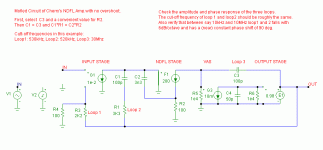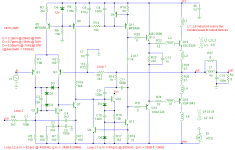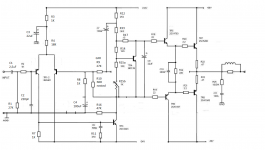The Halcro patent is a worthwhile read too...
Also used some feedforward as well, just to confuse the reader. 😉
_-_-bear
Also used some feedforward as well, just to confuse the reader. 😉
_-_-bear

jcx said:somehow I doubt there will be much action in a DIY thread that is restricted to Cherry's nested differentiating feedback loops as the sole acceptable example of nested feedback - nor is it clear that that is the op's definition
I see no reason to define nested feedback by any other criteria than as feedback loops "inside" the global or other local feedback loops, Matryoshka style or tangent loops would both fit the simple "nested" concept
this certainly includes local followers or degeneration as (perhaps trivial) examples of "nested" feedback loops inside the global, miller and/or other local feedback loops enclosing multiple stages
You might note that the Extrema Class A amp circuit has a local feedback from T29,30 around the tripple darlington output
http://www.diyaudio.com/forums/showthread.php?s=&threadid=96853
It really is a matter of interpretation. But for audio, as far as I am aware, it was Cherry who coined the term 'nested feedback loops' and in doing so he defined is as fb pick-off from the output and returning it to intermediate stages as Bricolo said above.
But, anybody can define it as he wants, the term is not (tm).
In discussions like this it would be helpful however if we all would understand it the same whatever it is.
Jan Didden
bear said:The Halcro patent is a worthwhile read too...
Also used some feedforward as well, just to confuse the reader. 😉
_-_-bear
Halcro is pretty good at picking up bits and pieces developed by others and disguising it into a new patent.
Jan Didden
Cherry's "nests" look a lot like the output feedback or state feedback canonical block diagrams so I don't think he can claim credit for "nested feedback" topologies
But "Cherry's nested differentiating feedback" or even "Cherry's nested feedback" seem specific enough and clearly refers to his published ideas - although current Op Amp design papers use "nested miller feeedback" and "reverse nested miller feedback" for similar circuits
Control folk seem to use "multiloop" or "multiple loop" very generically - although some in the audio hacking world may associate multiloop with Walt Jung's "Op Amp Audio" series
But "Cherry's nested differentiating feedback" or even "Cherry's nested feedback" seem specific enough and clearly refers to his published ideas - although current Op Amp design papers use "nested miller feeedback" and "reverse nested miller feedback" for similar circuits
Control folk seem to use "multiloop" or "multiple loop" very generically - although some in the audio hacking world may associate multiloop with Walt Jung's "Op Amp Audio" series
Edward Cherry's NDFL
See attachment for an other example of Cherry’s NDFL. I have changed some component in order to approve the step response and also changed the global feedback loop to a more common topology. Furthermore, I included some simple rules to calculate the specific NDFL components. Please feel free to contact me for a complete circuit diagram.
See attachment for an other example of Cherry’s NDFL. I have changed some component in order to approve the step response and also changed the global feedback loop to a more common topology. Furthermore, I included some simple rules to calculate the specific NDFL components. Please feel free to contact me for a complete circuit diagram.
Attachments
Hi al2002
sorry, I'm still waiting for clarification about the copyright owners for the Cherry papers.
Apparently Nexus bought ETI title, but it isn't clear whether Nexus hold copyright for these old papers...and the ETI people didn't respond either....
watch this space...
cheers
John
sorry, I'm still waiting for clarification about the copyright owners for the Cherry papers.
Apparently Nexus bought ETI title, but it isn't clear whether Nexus hold copyright for these old papers...and the ETI people didn't respond either....
watch this space...
cheers
John
bear said:The Halcro patent is a worthwhile read too...
Also used some feedforward as well, just to confuse the reader. 😉
_-_-bear
Hi Bear,
Do you mean this Halcro patent:
http://www.freepatentsonline.com/6798285.html
Regards,
bogdan_borko said:I didnt ment Aksa`s and Greg`s schematics (I know that only kit buyers have them and I respect that).
I meant some other design exaples of amp with nested feedback? Anyone round here designed such a amp?
Hi bogdan_borko,
Here is another example of a NDFL amp. Notice that I have also applied the transitional Miller compensation (TMC) to avoid possible instability that might occur when C9 is directly tied to the output. The NDFL components consist of R4, C1, C4, R11 and Q7. R6, C3 and C5 restore the balance of the current mirror.
Also note that the Rush PNP/NPN pair (as in Cherry's implementation) has been replaced by a single transistor (Q7). As there is already a current mirror, we can use just this one to create the 2nd stage lag compensation (C4). For more info, please contact me and see my previous post, but don’t ask for a formal analysis, as the critical component values I just figured out by fiddling with a simulator.
Cheers,
Attachments
Nested Differential Feedback (Feed Back) in German Electronic Magazine
in the no longer available German magazine "ELRAD" (from the same publisher of the popular computer magazine "Ct") this topology has been described in detail (February/March 1984 and an update to the old schematic in September 1988 and the ELRAD special edition number 2)
you can order copies there:
http://www.heise.de/
here an ebay auction about the "ELRAD 2" special edition
http://cgi.ebay.com.au/ws/eBayISAPI...49518&_sacat=See-All-Categories&_fvi=1&_rdc=1
http://209.85.129.132/search?q=cach...39cef7c8e+ELRAD+NDFL&cd=4&hl=de&ct=clnk&gl=de
here some additional advices about NDFL (go to page 51 post #505 and #506)
http://www.diyaudio.com/forums/software-tools/101810-spice-simulation.html
in the no longer available German magazine "ELRAD" (from the same publisher of the popular computer magazine "Ct") this topology has been described in detail (February/March 1984 and an update to the old schematic in September 1988 and the ELRAD special edition number 2)
you can order copies there:
http://www.heise.de/
here an ebay auction about the "ELRAD 2" special edition
http://cgi.ebay.com.au/ws/eBayISAPI...49518&_sacat=See-All-Categories&_fvi=1&_rdc=1
http://209.85.129.132/search?q=cach...39cef7c8e+ELRAD+NDFL&cd=4&hl=de&ct=clnk&gl=de
here some additional advices about NDFL (go to page 51 post #505 and #506)
http://www.diyaudio.com/forums/software-tools/101810-spice-simulation.html
Attachments
Last edited:
Member
Joined 2009
Paid Member
You might want to pick a value based on listening tests - if you can't hear it then does it matter ? Try 200k to start. Beware that it will affect your overall gain and dc-offset depending on details of implementation.
See also: "• Nested feedback is functionally equivalent to global feedback. "
https://linearaudio.net/sites/linearaudio.net/files/volume1bp.pdf
As recommended in this article, I built an amplifier with high feedback and it sounds better than my low feedback amplifiers (to date....)
See also: "• Nested feedback is functionally equivalent to global feedback. "
https://linearaudio.net/sites/linearaudio.net/files/volume1bp.pdf
As recommended in this article, I built an amplifier with high feedback and it sounds better than my low feedback amplifiers (to date....)
Last edited:
Hi Guys
The beginning of this thread took a left turn since it seemed that "nested" was taken to mean "nested differentiating" as in Cherry's article. Nested feedback is notso limited.
Any circuit with more than one feedback loop usually has at least one of those loops within another, so the inner one is "nested" within the output one. Bryston's amplifiers all use nested feedback, where there is the usual global feedback loop and within it are loops around each half of the output stage.
General nested loops are not that difficult to stabilise where Cherry's approach can be. Both forms of nested loops can provide very good performance.
To be nit picky, every circuit with a global feedback loop also has other loops within it because of the nature of the components themselves. Miller compensation is a loop within the loop, as an example.
Have fun
The beginning of this thread took a left turn since it seemed that "nested" was taken to mean "nested differentiating" as in Cherry's article. Nested feedback is notso limited.
Any circuit with more than one feedback loop usually has at least one of those loops within another, so the inner one is "nested" within the output one. Bryston's amplifiers all use nested feedback, where there is the usual global feedback loop and within it are loops around each half of the output stage.
General nested loops are not that difficult to stabilise where Cherry's approach can be. Both forms of nested loops can provide very good performance.
To be nit picky, every circuit with a global feedback loop also has other loops within it because of the nature of the components themselves. Miller compensation is a loop within the loop, as an example.
Have fun
Hi. Thanks for explanations .
I need to calculate the value of the resistor R10. There is some relationship between R8, R9, R10? Is there any relationship between nested and global feedback gain?
I need to calculate the value of the resistor R10. There is some relationship between R8, R9, R10? Is there any relationship between nested and global feedback gain?
Hi all.
My question is how the value of the resistor (R10) is calculated, neested feedback resistor. Global feedback is 28. (R9/R8 +1= 28).
For the feedback level calculations you can asume that R10 is connected to the output, it has (almost) the same level. So the total feedback factor can be calculated by taking the // value of R10 and the 'normal' feedback R.
If you want to split the feedback equal between the two loops you just make the two fed back resistors equal.
Jan
Yes, so the key thing for GEirin to decide - how much feedback he'd like to leave over the OPS and for what reason (assuming overall gain stays the same).
This is the most "difficult" question.
Calculation is easy.
This is the most "difficult" question.
Calculation is easy.
As a close approximation, and assuming we are using resistive fb both for global and nested, the ratio of nested fb resistor to the global feedback gives you the ratio of the global feedback. So, for example from a quasi we are examining at present, 68k/1k8 = 37.7 which 31.5dB. The closed loop gain is the paralleled 68k and 1k8, 1k754 factored with the 68R feedback shunt resistor, which is 26.8 which is 28.56dB.
HD
HD
Which currently available commercial amps use this kind of NFB ??
Hi Tiefbassuebertr,
I don't know about the currently available ones, but in the past - SONY TA-NR1 had two feedback loops (nested) - one feedback is connected to the output of the pre-drivers stage, the other one - to the output of the power section.
The ratio is 50/50 (same feedback resistors' value).
Other specialties - two output sections in parallel for higher output current capability and bias spreader, covering both sections.
I like the design a lot.
Service manual with schematic is available at hifiengine:
SONY TA-NR1 service manual
I experimented with nested feedback in my Vertical VFA + NS-OPS design. The best (to my taste) loop gains ratio is shown here - see the feedback R values on the picture - they are actually close to 50/50 as well:
Vertical VFA's nested feedback arrangement
Cheers,
Valery
I would think the main reason for this split feedback is that you don't want to include all of the driver/output device phase shift in the overall loop.
By splitting it between output and (pre) driver would help stability, but can be expected to give less distortion reduction.
OTOH, if the split allows you more overall loop gain it may compensate for the higher distortion and in the end come out the same.
Hard to see any specific advantage seen from outside looking at the complete amplifier.
Jan
By splitting it between output and (pre) driver would help stability, but can be expected to give less distortion reduction.
OTOH, if the split allows you more overall loop gain it may compensate for the higher distortion and in the end come out the same.
Hard to see any specific advantage seen from outside looking at the complete amplifier.
Jan
- Home
- Amplifiers
- Solid State
- What is nested feedback, how it realy works and some examples...


